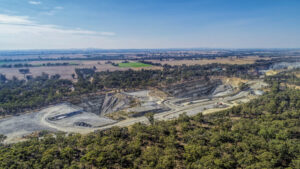These Africa-focused ASX miners could benefit from a loosening of local laws

An African elephant in Serengeti national park, Tanzania. Pic: Getty
Positive political moves in Zimbabwe and Tanzania are providing hope for ASX-listed miners looking to get projects off the ground.
Zimbabwe looks set for greater stability after a challenge to the recent election result was settled last week and Emmerson Mnangagwa was confirmed as president.
And in Tanzania, there looks to be a thawing of relationships with foreign investors after the government moved to take compulsory stakes in miners last year.
In Zimbabwe, foreign investment stalled under former President Robert Mugabe’s reign – leaving a country rich in resources largely underexplored.
Mr Mugabe was deposed in a coup in November.
>> Scroll down for a list of ASX stocks with projects in Zimbabwe and Tanzania, courtesy of leading ASX data provider MakCorp
President Mnangagwa was inaugurated last week and while it’s still early days, those close to the situation believe there are rays of sunshine emerging for the mining sector.
“There have been a few changes to the mining code, which allow … more foreign ownership of projects,” Bill Witham, head of the Australia-Africa Minerals & Energy Group told Stockhead.
“We see it heading in the right direction, but really at the moment it’s more about politically stability,” Mr Witham said on the sidelines of an “Africa Down Under” conference in Perth last week.
“I think everyone is taking a breather, just having a look making sure that the stability on the ground is good in the country, and then I think we’ll see a reasonable amount of investment, because Zimbabwe is incredibly well endowed with minerals.”
- Subscribe to our daily newsletter
- Bookmark this link for small cap news
- Join our small cap Facebook group
- Follow us on Facebook or Twitter
Bronte Moules, Australia’s Ambassador to Zimbabwe, said it was too early to provide “firm and fast predictions” but the signs were positive.
“There are a few points that I think are positive almost irrespective of what happens,” Ms Moules said at the conference.
“One is the consistent message from the government and from the president about opening up Zimbabwe and the desire for change.
“I think it’s genuine. It’s coming through in that way, and certainly in President Mnangagwa’s inauguration speech on Sunday there was a big emphasis on reform and development and on the economic development, which is so needed for the country’s international re-engagement.”
Here’s a list of ASX stocks with projects in Zimbabwe and Tanzania, courtesy of leading ASX data provider MakCorp. (Scroll or swipe for full table)
Swipe or scroll to reveal the full table. Click on headings to sort
| ASX code | Company | Country | Focus | 12-month price change | 6-month price change | Price Aug 31 (intraday) | Market Cap |
|---|---|---|---|---|---|---|---|
| AGG | ANGLOGOLD | Tanzania | Gold | -0.0833333333333 | -0.108108108108 | 2.31 | 4.5B |
| BKT | BLACK ROCK | Tanzania | Graphite | -0.209302325581 | -0.358490566038 | 0.034 | 14.9M |
| CKA | COKAL | Tanzania | Coal | -0.479452054795 | -0.191489361702 | 0.038 | 25.9M |
| CXX | CRADLE RESOURCES | Tanzania | Niobium | -0.253846153846 | -0.15652173913 | 0.097 | 18.5M |
| GPX | GRAPHEX MINING | Tanzania | Graphite | -0.0222222222222 | -0.3125 | 0.22 | 17.0M |
| IDA | INDIANA RES | Tanzania | Gold, nickel, graphite | -0.0526315789474 | -0.129032258065 | 0.054 | 5.2M |
| IEC | INTRA ENERGY | Tanzania | Lithium, graphite, thermal coal | -0.0769230769231 | -0.333333333333 | 0.012 | 4.7M |
| KNL | KIBARAN RES | Tanzania | Graphite, nickel | -0.0625 | -0.0625 | 0.15 | 41.4M |
| LCD | LATITUDE CONS | Zimbabwe | Lithium, tantalum | 0.352941176471 | -0.258064516129 | 0.023 | 6.6M |
| LIN | LINDIAN RESOURCE | Tanzania | Gold, bauxite | 0.285714285714 | -0.25 | 0.018 | 6.0M |
| LTR | LIONTOWN RESOURC | Tanzania | Gold | 1.90909090909 | -0.219512195122 | 0.032 | 35.3M |
| MNS | MAGNIS RESOURCES | Tanzania | Graphite | 0 | -0.0506329113924 | 0.375 | 214.8M |
| MSR | MANAS RESOURCES | Tanzania | Gold | 0.25 | 0 | 0.005 | 13.2M |
| ORR | ORECORP | Tanzania | Gold | 1 | 0.217391304348 | 0.28 | 59.5M |
| PEK | PEAK RESOURCES | Tanzania | Rare Earths | -0.25 | -0.365384615385 | 0.033 | 24.8M |
| PSC | PROSPECT RESOURC | Zimbabwe | Gold, copper, silver, lithium, tantalum | 0.037037037037 | -0.416666666667 | 0.028 | 55.5M |
| RVY | RIFT VALLEY RESO | Tanzania | Gold | -0.208333333333 | -0.136363636364 | 0.019 | 17.5M |
| SI6 | SIX SIGMA METALS | Zimbabwe | Vanadium, titanium, copper, lithium | -0.25 | -0.4 | 0.009 | 4.6M |
| STA | STRANDLINE RES | Tanzania | Mineral Sands | 1.83333333333 | 0.36 | 0.17 | 49.9M |
| TRL | TANGA RESOURCES | Tanzania | Gold | -0.5 | -0.5 | 0.007 | 5.1M |
| VRC | VOLT RESOURCES | Tanzania | Graphite | 0 | -0.457142857143 | 0.019 | 27.7M |
| WKT | WALKABOUT RES | Tanzania | Graphite, vanadium | 0.65 | 0.79347826087 | 0.165 | 44.7M |
| ZIM | ZIMPLATS | Zimbabwe | Platinum | 0.333333333333 | -0.0977443609023 | 6 | 645.8M |
There are five ASX-listed explorers in Zimbabwe.
In July, Lithium Consolidated (ASX:LI3) was granted seven new lithium projects in the Mutare Greenstone Belt in eastern Zimbabwe.
Zimbabwe has long been a significant producer of lithium and is currently the 5th largest producer in the world.
The largest single producer is the Bikita mine, where resources of around 11 million tonnes at 1.4 per cent lithium have been mined for over 60 years.
In April, Latitude Consolidated (ASX:LCD) — which has attracted a scion of the Eckhoff mining clan to its board, Klaus Eckhof’s daughter Kim — bought the Mbeta lithium project in the south of the country from Zimbabwean national Robert David Hutchings.
It was the company’s first foray into Zimbabwe and introduced by Mr Eckhof and his colleague Mark Gasson, who are sourcing other projects in Africa for Latitude.
Prospect Resources (ASX:PSC), meanwhile, received the mining lease for its Arcadia lithium mine two weeks ago.
In April, the company completed a $10 million placement and $US557 million lithium supply deal with Chinese company Sinomine.
Tanzania powers through backlog of licences
In Tanzania, the government is now working to get through a massive backlog of mining licences after a whirlwind year that involved several changes to the Mining Act and a backlash from miners.
The Australia-Africa Minerals & Energy Group is still working to iron out some of the legislative issues, but things are looking positive.
“I think we’re seeing a thawing in some of the issues,” group CEO Bill Witham told Stockhead.
“Everyone is getting much more positive and seeing the machinery of government moving again,” he said.
Strandline Resources (ASX:STA) is the latest to receive its mining licence for the Fungoni heavy mineral sands project
The $US30 million ($41.4 million) Fungoni project, which is located about 25km from Dar es Salaam port, is expected to produce 2 million tonnes each year of heavy mineral sands including ilmenite, rutile and zircon.
Ilmenite is the main source of titanium dioxide, which is used in paints, fabrics, plastics, paper, sunscreen, food and cosmetics.
Zircon, meanwhile, has a high melting point, making it ideal for use in engines, electronics, spacecraft and the ceramics industry.
Rutile is also used in the manufacture of ceramics, as a pigment, and for the production of titanium metal.
With the mining licence now in hand, Strandline can get cracking on locking down the debt and equity funding for the project.
Walkabout Resources (ASX:WKT) was also granted its mining licence last week for the Lindi Jumbo graphite project.
It was the first ASX-listed company to be granted a mining licence in Tanzania.
“Securing the mining licence means Walkabout can now fast-track Lindi Jumbo and we anticipate first shipments of large flake graphite concentrate within nine to 12 months,” he told delegates on the second day of the Africa Down Under conference last week.
Walkabout plans to supply about 25 per cent of its graphite to the battery market with the rest to supply high-value markets like expandable graphite.
Kibaran Resources (ASX:KNL), meanwhile, is developing its 60,000-tonne-per-annum Epanko graphite project in Tanzania.
The Epanko project, which has a net present value of US$211 million, has supply agreements already in place with European and Japanese customers, as well as debt financing support from German and Australian lenders for its estimated $US89 million pre-production capital cost.
Kibaran is targeting the rapidly growing lithium-ion battery market.
Chairman Robert Pett said Kibaran’s contribution to the Tanzanian economy would be substantial.
“It would help position Tanzania as a major player in this massive new global industry, offer both natural flake graphite production and a new value-adding manufacturing industry and expand trade partnerships into growth economies such as Germany, South Korea, Japan and North America,” he said at Africa Down Under.
UNLOCK INSIGHTS
Discover the untold stories of emerging ASX stocks.
Daily news and expert analysis, it's free to subscribe.
By proceeding, you confirm you understand that we handle personal information in accordance with our Privacy Policy.








